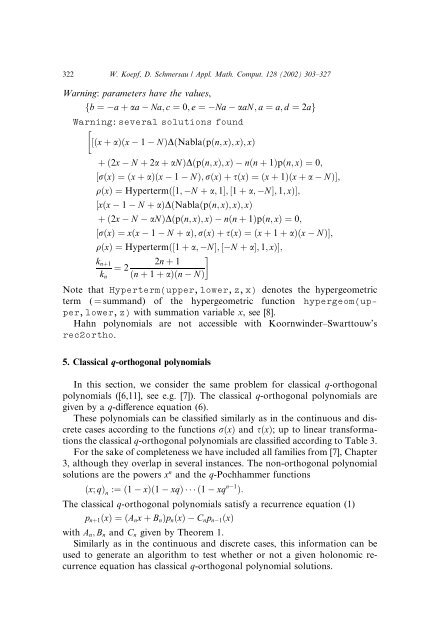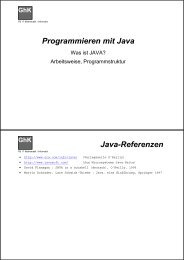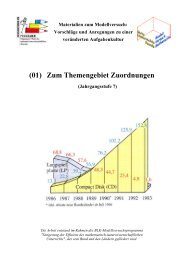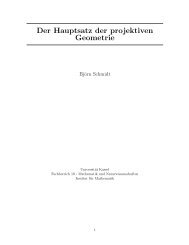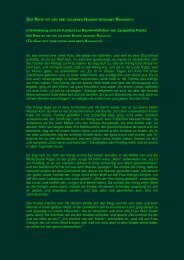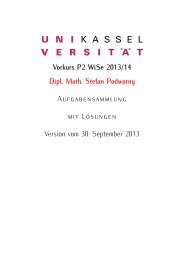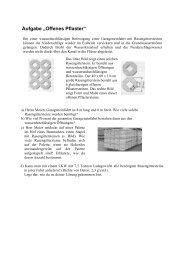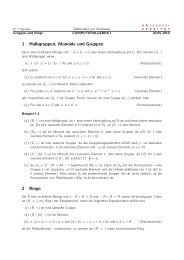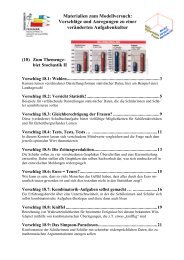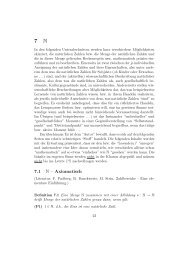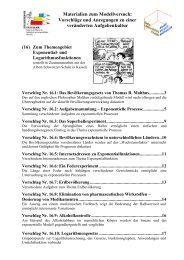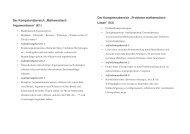Recurrence equations and their classical orthogonal polynomial ...
Recurrence equations and their classical orthogonal polynomial ...
Recurrence equations and their classical orthogonal polynomial ...
You also want an ePaper? Increase the reach of your titles
YUMPU automatically turns print PDFs into web optimized ePapers that Google loves.
322 W. Koepf, D. Schmersau / Appl. Math. Comput. 128 (2002) 303–327<br />
Warning: parameters have the values,<br />
fb ¼ a þ aa Na; c ¼ 0; e ¼ Na aaN; a ¼ a; d ¼ 2ag<br />
Warning:several solutions found<br />
½ðx þ aÞðx 1 NÞDðNablaðpðn; xÞ; xÞ; xÞ<br />
þð2x N þ 2a þ aNÞDðpðn; xÞ; xÞ nðn þ 1Þpðn; xÞ ¼0;<br />
½rðxÞ ¼ðxþ aÞðx 1 NÞ; rðxÞþsðxÞ ¼ðxþ 1Þðx þ a NÞŠ;<br />
qðxÞ ¼Hypertermð½1; N þ a; 1Š; ½1 þ a; NŠ; 1; xÞŠ;<br />
½xðx 1 N þ aÞDðNablaðpðn; xÞ; xÞ; xÞ<br />
þð2x N aNÞDðpðn; xÞ; xÞ nðn þ 1Þpðn; xÞ ¼0;<br />
½rðxÞ ¼xðx 1 N þ aÞ; rðxÞþsðxÞ ¼ðxþ 1 þ aÞðx NÞŠ;<br />
qðxÞ ¼Hypertermð½1 þ a; NŠ; ½ N þ aŠ; 1; xÞŠ;<br />
knþ1<br />
kn<br />
2n þ 1<br />
¼ 2<br />
ðn þ 1 þ aÞðn NÞ<br />
Note that Hyperterm(upper,lower,z,x) denotes the hypergeometric<br />
term ( ¼ summ<strong>and</strong>) of the hypergeometric function hypergeom(upper,lower,z)<br />
with summation variable x, see [8].<br />
Hahn <strong>polynomial</strong>s are not accessible with Koornwinder–Swarttouw’s<br />
rec2ortho.<br />
5. Classical q-<strong>orthogonal</strong> <strong>polynomial</strong>s<br />
In this section, we consider the same problem for <strong>classical</strong> q-<strong>orthogonal</strong><br />
<strong>polynomial</strong>s ([6,11], see e.g. [7]). The <strong>classical</strong> q-<strong>orthogonal</strong> <strong>polynomial</strong>s are<br />
given by a q-difference equation (6).<br />
These <strong>polynomial</strong>s can be classified similarly as in the continuous <strong>and</strong> discrete<br />
cases according to the functions rðxÞ <strong>and</strong> sðxÞ; up to linear transformations<br />
the <strong>classical</strong> q-<strong>orthogonal</strong> <strong>polynomial</strong>s are classified according to Table 3.<br />
For the sake of completeness we have included all families from [7], Chapter<br />
3, although they overlap in several instances. The non-<strong>orthogonal</strong> <strong>polynomial</strong><br />
solutions are the powers xn <strong>and</strong> the q-Pochhammer functions<br />
ðx; qÞn :¼ð1 xÞð1 xqÞ ð1 xq n 1 Þ:<br />
The <strong>classical</strong> q-<strong>orthogonal</strong> <strong>polynomial</strong>s satisfy a recurrence equation (1)<br />
pnþ1ðxÞ ¼ðAnxþ BnÞpnðxÞ Cnpn 1ðxÞ<br />
with An; Bn <strong>and</strong> Cn given by Theorem 1.<br />
Similarly as in the continuous <strong>and</strong> discrete cases, this information can be<br />
used to generate an algorithm to test whether or not a given holonomic recurrence<br />
equation has <strong>classical</strong> q-<strong>orthogonal</strong> <strong>polynomial</strong> solutions.


